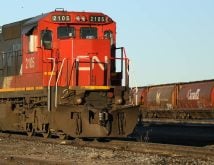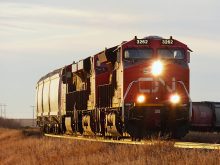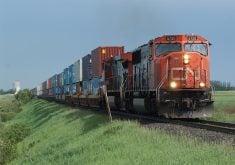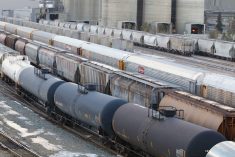The Canadian agriculture sector is taking stock after the labour dispute between Canada’s two main railways and the Teamsters Canada Rail Conference union came to a rolling boil last week.
Just after midnight Aug. 22, Canadian Pacific Kansas City and the Canadian National Railway made good on their threat to lock out employees. The TCRC had also served strike notice to CPKC, to begin Aug. 22.
Related stories: WP rail labour dispute coverage
Read Also

Alberta eases water access for riparian restoration
Alberta government removes requirement for temporary diversion licence to water plants up to 100 cubic metres per day for smaller riparian restoration projects
Less than 16 hours after the lockout began, Canadian Labour Minister Steven MacKinnon intervened. He invoked Section 107 of the Labour Code, instructing the Canada Industrial Relations Board (CIRB) to extend the term of the current collective agreements until a new agreement could be reached through binding arbitration.
Multiple companies, farm groups, other industry associations and farmers had called on MacKinnon to make that move before the Aug. 22 lockout date, a push that included a multi-stakeholder “Stop the Strike” letter-writing campaign asking the public to add weight to the call.
The federal government was reluctant to step in. A week before the lock out, MacKinnon told the TCRC that the government would let negotiations play out.
The federal move was not the end of the dispute. On Aug. 23, Reuters reported that the TCRC said it would challenge the constitutionality of MacKinnon’s Section 107 invocation. In a post on the social media platform X, the TCRC said it was “consulting with legal counsel to determine the next steps.”
CN workers were set to return to work Aug. 23, but on that same day, the TCRC filed strike notice to CN, to begin Aug. 26.
As well, the lockout at CPKC lingered.
A release from CPKC late Aug. 22 accused the TCRC of refusing “to discuss any resumption of service … as well as the CIRB’s discretion to proceed with any order,” with more case management meetings scheduled the following day.
On Aug. 24, the CIRB ordered union members back to work, effective 12:01 a.m. EST Aug. 26.
The union said it would comply but vowed to appeal the ruling.
As of press time Aug. 26, it was thought it could take weeks for rail movement to return to normal. For all the latest developments, visit producer.com.
Those in the grain industry worried that even a short work stoppage would have cascading effects. The country has never seen a labour dispute that resulted in a strike or lockout from both of Canada’s major rail companies. At the same time, combines are running in Western Canada and new crop is flowing in.
“The recovery timeline is about a week for every day we lose,” said Wade Sobkowich, executive director of the Western Grain Elevator Association. “You’re playing catch up.”
In a release Aug. 23, urging all parties involved to get the trains rolling as quickly as possible, Grain Growers of Canada said it costs farmers $50 million for every day the railways are shut down.
Keystone Agricultural Producers general manager Brenna Mahoney also said she hopes delays don’t add to farmers’ anguish.
“Farmers are pulling crop off the field right now. They have bills to pay from inputs this past year. They’re already under so much stress and strain.”
These events come in the wake of the CIRB ruling Aug. 9 that rail service was not considered an essential service, based on the labour code’s definition, so a strike could go ahead. Proceedings had been paused for months pending that decision.
The railways and the TCRC have been negotiating since November 2023, and the collective agreement expired in December. The talks stalled over issues including wages, scheduling and fatigue management.
On May 1, the employees of the two railways voted overwhelmingly for strike action, which invoked a 21-day mandatory cooling off period, meaning a strike could happen as soon as May 22. On May 9, then labour minister Seamus O’Regan asked the CIRB to rule on whether rail traffic was an essential service.
There were limited negotiations and a few attempts to bridge the gap in the ensuing months. Both railways proposed binding arbitration as a resolution later in May, a proposal rejected by the union. An update on the Teamsters website stated, “These carriers are only pushing for binding arbitration to attain concessions that they cannot achieve through collective bargaining.”
In June, the TCRC offered the possibility of staggered strikes to lessen the impact of work stoppages, which the railways rejected. On its bargaining update page, CN said that would prolong the risk of extending the strike.
“It is like suffering death by a thousand cuts,” read its response.
By the time CIRB released its August ruling, the two sides were no closer together.
The CIRB ruling, that rail traffic is not essential, was met with surprise, given potential economic impact of a rail stoppage. The document did acknowledge that a stoppage would result in inconvenience and economic hardship, and might harm Canada’s reputation as a global trading partner.
But according to the labour code, the threshold for essential service is a service that, if stopped, would “pose an immediate and serious danger to the safety or health of the public.”
The CIRB said the railways provide no services that meet the threshold.
None of the parties disputed that. On Feb. 1, CN wrote a letter to the TCRC echoing that position, an excerpt of which was later included in the CIRB ruling.
“The company notes that, while its services are essential to both the Canadian and the global economy, it does not dispute your position that these services are not necessary to prevent an immediate and serious danger to the safety or health of the public.”
In a June 11 release, CN said uncertainty around the timing of a labour disruption was already hurting CN employees and the Canadian economy at large.
“The Minister of Labour’s request to the Canadian Industrial Relations Board (CIRB) on the issue of essential services is adding to this uncertainty,” the release read.
Greg Northey, vice-president of corporate affairs with Pulse Canada, later echoed that concern.
“When the government asked the CIRB to assess … back in May, it just paused everything,” he said. “It took three months for them to come to that conclusion, and now we’re back, back where we started.”
Northey is the spokesperson for the Stop the Lockout campaign. He said the new timing of the dispute couldn’t be worse.
“The repercussions are going to be massive for us because we’re in the middle of harvest.”
The CIRB also had to rule on the 21-day cooling-off period. It was TCRC’s position that a cooling-off period wasn’t necessary and that, if there was one, it should only be seven days. The railways were asking for a 30-day cooling-off period so they could prepare for the labour stoppage.
Without a cooling-off period, a strike could have begun as soon as 72 hours after the CIRB released its decision. This would have left little time for the railways to prepare, which the board felt would “not be conducive to harmonious labour relations.”
The board ruled that, since there were 13 days left in the 21-day cooling off period when the minister intervened back in May, that cooling off period would continue after it released its ruling on Aug. 9, leading to the Aug. 22 deadline.


















